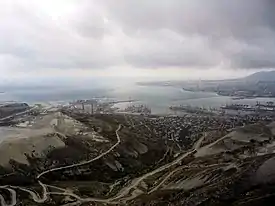Tsemes Bay
The Tsemes Bay (also Tsemess Bay and Novorossiysk Bay; Russian: Цемесская бухта, Tsemesskaya bukhta) is an ice-free bay located on the northern coast of the Black Sea, in Krasnodar Krai of Russia. It takes its name from the Tsemes River which flows into the bay. The depth of the sea varies from 21 to 27 meters. The length of the bay is 15 kilometers; its maximum width is 9 kilometers. It is bordered by the Sudzhuk Spit and Cape Doob.

Although the navigation is affected by strong autumn and winter bora winds (up to 220 kilometers per hour), the bay was frequented by ancient Greek navigators who established the colony of Bata on the shore. Michael Rostovtzeff explained this by the fact that there are no other decent harbours along the coastline all the way to Batumi.[1] During the Middle Ages, the coast was controlled by the Ghisolfi merchant family of Genoa.
Novorossiysk, founded by Russians as a military facility, is the chief port on the bay. Several ships of the Black Sea Fleet were scuttled in the bay to avoid their capture by the Germans in 1918. It was also the scene of several notable shipwrecks, including that of SS Admiral Nakhimov in 1986. Following the establishment of the Caspian Pipeline Consortium, the Commercial Seaport of Novorossiysk has emerged as the busiest oil terminal in the Black Sea. The southern portion of the bay, with the minor resort of Kabardinka, is administered from Gelendzhik (see Gelendzhik Bay).
References
- Rostovtzeff, Michael Ivanovich. Iranians and Greeks in South Russia. The Clarendon Press, 1922. Page 63.